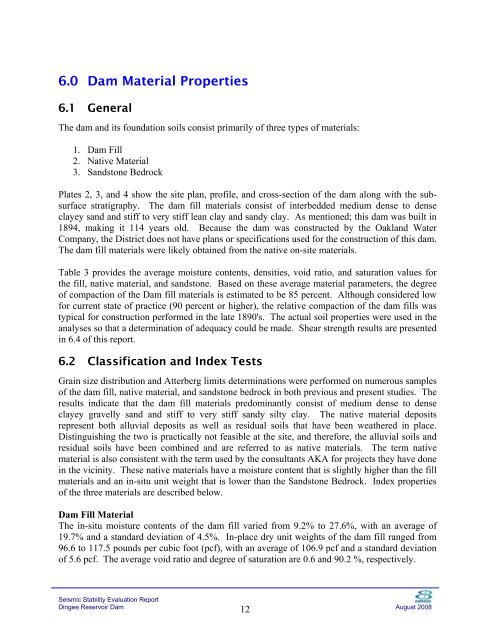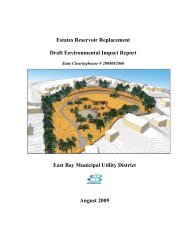Dingee Reservoir Final Seismic Report - East Bay Municipal Utility ...
Dingee Reservoir Final Seismic Report - East Bay Municipal Utility ...
Dingee Reservoir Final Seismic Report - East Bay Municipal Utility ...
- No tags were found...
Create successful ePaper yourself
Turn your PDF publications into a flip-book with our unique Google optimized e-Paper software.
6.0 Dam Material Properties<br />
6.1 General<br />
The dam and its foundation soils consist primarily of three types of materials:<br />
1. Dam Fill<br />
2. Native Material<br />
3. Sandstone Bedrock<br />
Plates 2, 3, and 4 show the site plan, profile, and cross-section of the dam along with the subsurface<br />
stratigraphy. The dam fill materials consist of interbedded medium dense to dense<br />
clayey sand and stiff to very stiff lean clay and sandy clay. As mentioned; this dam was built in<br />
1894, making it 114 years old. Because the dam was constructed by the Oakland Water<br />
Company, the District does not have plans or specifications used for the construction of this dam.<br />
The dam fill materials were likely obtained from the native on-site materials.<br />
Table 3 provides the average moisture contents, densities, void ratio, and saturation values for<br />
the fill, native material, and sandstone. Based on these average material parameters, the degree<br />
of compaction of the Dam fill materials is estimated to be 85 percent. Although considered low<br />
for current state of practice (90 percent or higher), the relative compaction of the dam fills was<br />
typical for construction performed in the late 1890's. The actual soil properties were used in the<br />
analyses so that a determination of adequacy could be made. Shear strength results are presented<br />
in 6.4 of this report.<br />
6.2 Classification and Index Tests<br />
Grain size distribution and Atterberg limits determinations were performed on numerous samples<br />
of the dam fill, native material, and sandstone bedrock in both previous and present studies. The<br />
results indicate that the dam fill materials predominantly consist of medium dense to dense<br />
clayey gravelly sand and stiff to very stiff sandy silty clay. The native material deposits<br />
represent both alluvial deposits as well as residual soils that have been weathered in place.<br />
Distinguishing the two is practically not feasible at the site, and therefore, the alluvial soils and<br />
residual soils have been combined and are referred to as native materials. The term native<br />
material is also consistent with the term used by the consultants AKA for projects they have done<br />
in the vicinity. These native materials have a moisture content that is slightly higher than the fill<br />
materials and an in-situ unit weight that is lower than the Sandstone Bedrock. Index properties<br />
of the three materials are described below.<br />
Dam Fill Material<br />
The in-situ moisture contents of the dam fill varied from 9.2% to 27.6%, with an average of<br />
19.7% and a standard deviation of 4.5%. In-place dry unit weights of the dam fill ranged from<br />
96.6 to 117.5 pounds per cubic foot (pcf), with an average of 106.9 pcf and a standard deviation<br />
of 5.6 pcf. The average void ratio and degree of saturation are 0.6 and 90.2 %, respectively.<br />
<strong>Seismic</strong> Stability Evaluation <strong>Report</strong><br />
<strong>Dingee</strong> <strong>Reservoir</strong> Dam<br />
12<br />
August 2008

















